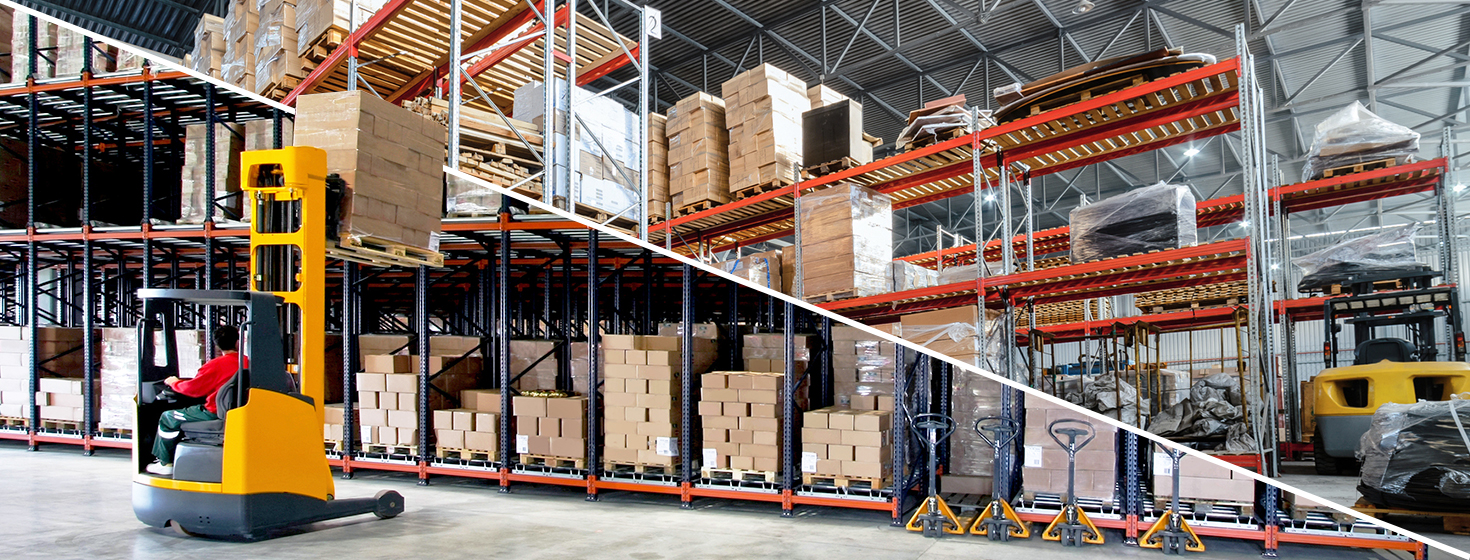7 Ecommerce Enabled Warehouse Best Practices

With ecommerce sales climbing by double-digit numbers every quarter, here are some best practices warehouse and DC managers can try to work better, smarter and faster.
Support for Ecommerce Operations
As manufacturers, distributors and retailers all strive to run efficient operations that not only meet the demands of their traditional businesses but also support their ecommerce operations, the race is on to develop efficient, optimized warehouses and DCs to support these multifaceted operations.
Driven by the sheer volume of products and services being sold online - a whopping $3.34 billion on Black Friday alone in the United States, according to data from Adobe Digital Insights - everyone wants to capture a slice of the 11.3% of total retail sales that are being transacted virtually, according to the U.S. Commerce Department.
Achieving that goal hasn’t been easy. “A lot of companies have been caught off guard by the growth in ecommerce,” says Ian Hobkirk, founder and managing director of Commonwealth Supply Chain Advisors.
“In fact, I was just in a DC the other day that was still using paper counts and that had no visibility over what was out in trucks versus in its warehouse until a week after the deliveries were made.”
The good news is that for every company that’s still playing catch-up in the ecommerce fulfillment game, there’s at least one organization (and countless vendors) that have already uncovered some solid best practices for tackling those challenges. Here are seven of them:
1. Start small by implementing a cluster-picking strategy
By picking into multiple order containers (e.g., totes containing order batches or discrete order totes), companies can effectively pick multiple orders at one time using a single cart. And, make sure that cart is sizable (i.e., 5 feet x 2 feet with at least two or three shelves) and able to handle the multiple orders, Hobkirk says.
“I go into operations and see people using these tiny, 2-foot x 2-foot carts to pick two items and then push those orders across the entire warehouse,” he says. “If you can get a little bigger cart that can accommodate a few totes or boxes at a time, you can drive up your pick rates, instead of having to make 20 trips through the warehouse to pick 20 orders.”
2. Develop all-purpose facilities that “talk” to one another
Over the last few years, Jeff Mueller, vice president at Sedlak Management Consultants, has seen more emphasis on creating all-purpose facilities that can handle small orders, medium orders, and large orders - and that can do it all in a very accurate manner.
Going a step further, he says, firms are using IT-enabled systems and distributed order management (DOM) solutions at both the distribution and the retail levels to ensure smooth and seamless processes to and from those all-purpose warehouses and DCs.
“The goal is to be able to ship inventory from any point, stores included,” says Mueller, “and in a way that allows companies to accurately maintain inventory accuracy and follow through in a very cohesive manner.
You can’t do it all in one place (i.e., the warehouse) and not in other (the store). You have to be able to do it all at once.”
3. Design facilities with Omnichannel in mind
Defined as a multichannel approach to sales focused on providing customers with a seamless shopping experience - be it shopping online, ordering by phone, or shopping in a retail store -omnichannell is a primary focus for product-oriented companies.
That focus has transcended the modern-day supply chain and is impacting the way organizations design their warehouses and DCs.
Consider, for example, the company whose materials handling system is really only going to get over-stressed for a short period of time during the course of a year (during the holiday season or the summer, for example).
In this case, having a DC that handles direct to consumer (D2C) retail, D2C ecommerce, and wholesale distribution under a single roof can eke out the most value from its automation and its available labor force.
“That way you don’t wind up with a facility that only sees heavy use for short periods,” says Hobkirk, noting that additional omni-channel best practices include simplifying processes for temporary workers (e.g., by using voice-directed picking) and reducing learning curves for those employees.
“That way, someone who has never been at a specific location before can get very minimal training and be productive within a short period of time.”
4. Level-load orders year-round to offset spikes and lows
When he talks to DC managers these days, Mueller says a lot of them are concerned about how to even out the ebbs and flows of their companies’ ecommerce fulfillment operations.
“They’re trying to find a better way to achieve balance throughout the year and also have a more stable workforce,” says Mueller, “particularly when these managers have 100 to 200 temps coming in to help during the holidays - a model that, interestingly enough, hasn’t panned out quite the way some expected it to.”
In some scenarios, ensuring that orders are level-loaded throughout the year can help offset at least some of that temporary labor challenge, he notes.
“With level-load orders, there isn’t as much immediacy, which basically drives people to call a temp agency on Monday morning with a request for hundreds of workers,” says Mueller, who advises DC managers to “get in tune” with the rest of the company to ensure better planning and to avoid a glut of orders that are waiting to be processed during the high season.
“Try to avoid creating a hole that you might not be able to dig yourself out of,” Mueller says, “in time to still beat the holiday delivery deadlines.”
5. Turn to your WMS for help
If you thought your warehouse management system (WMS) was only for tracking inventory levels and identifying stock locations, think again.
Today’s WMS solutions are well equipped to take on some of the key challenges associated with ecommerce fulfillment.
“The retail fulfillment picture has changed, and we’re seeing a much higher volume of smaller orders - a trend that’s pushing companies to invest in more automation,” says Clint Reiser, research analyst with ARC Advisory Group.
In some cases, WMS vendors are stepping up to the plate and building more automated processes in their systems, all with the goal of enabling the “goods-to-person” process.
For instance, Reiser says some WMS vendors are building put-wall functionalities into their applications that allow employees using put-to-light or pick-to-light technology to select two or three items from one order and put them into one box for shipping. He points to Manhattan’s pack station user interface and order streaming functionalities as examples of these new features in action.
6. Understand the seasonality of your business
It’s no secret that U.S. ecommerce sales growth continues to outpace stores. During the third quarter of 2016, for example, the Internet represented 11.3% of total retail sales, up from 10.9% during the second quarter, according to the U.S. Commerce Department.
But not all ecommerce sales are equal, nor do they all warrant the same amount of attention and energy. This is a reality that Hobkirk often has to work through with companies, not all of which have a solid grasp on the seasonality of their businesses.
Consider the fact that the retail wholesale holiday surge comes at a different time than the direct consumer holiday surge, he says. Where a DC handling wholesale orders may be busiest from September through November - as it strives to get products out to the stores in advance of the shopping seasons - the warehouse managing D2C orders probably has its biggest labor needs during the month of December.
“If you have both of these operations under one roof,” says Hobkirk, “you have to be able to smooth that out on the labor front.” In some cases, that may mean having a year-round staff that’s augmented from September through December with temp workers who can help carry the operations through its busiest period. And if you time it right, that temp labor can be easily carried through both periods,” says Hobkirk.
“When you understand the seasonality of your business, you can make these types of decisions and save the hassle of having to re-hire and re-train workers. You can just better leverage your common labor pool.”
7. Test out the “pop-up fulfillment” approach
Much like a retailer would open a pop-up store to take advantage of a particular shopping season (i.e., a holiday-oriented shop that fills empty/available mall space only from October-December), companies are leveraging pop-up fulfillment locations to accommodate their ecommerce orders.
Mueller says this trend emerged in 2016, and he expects it to continue as companies strive to find the best possible ways to fill ecommerce orders from their warehouses and DCs. For instance, he says the organization that invested heavily in its core fulfillment centers, and that’s handling 100,000 SKUs in those facilities, might consider opening a smaller, regional facility to manage a portion of the fastest-moving SKUs.
Mueller sees this happening just outside of key urban hubs like Chicago, New York, and Los Angeles. “The ‘mother’ fulfillment center ships into these regional, pop-up centers, which are only operational for about three months,” he says.
“Then, the pop-ups service the firm’s regional customers in a more labor-effective, service-oriented manner.”
Related: The Difference between a Traditional Warehouse and an OmniChannel Warehouse
Related e-Commerce White Papers
The Five “New Rules” of 3PL e-Commerce Fulfillment
The purpose of this white paper is to spell out “The Five New Rules of 3PL e-Commerce Fulfillment.” rules and explain how they will benefit your 3PL warehouse, it also provides the guidance you need to help your 3PL e-Commerce fulfillment business prepare for future growth. Download Now!
Transform Global e-Commerce and Maximize the Customer Experience
Global e-commerce is growing in leaps and bounds, particularly in emerging markets, where consumers can find it hard to locate affordable imported products. Download Now!
Global E-Commerce Logistics 2016
The report contains Ti’s bespoke market size and forecasting data, as well as overviews of some of the world’s leading e-commerce businesses, such as Alibaba and Amazon. Download Now!
Precise Cross-Belt Sortation: Unlocking Efficient E-Commerce Distribution
In the burgeoning e-commerce market, speedy delivery and diverse offerings are customer expectations, and the ability to deliver these via a seamless customer experience will increasingly separate leaders from laggards. Download Now!
Five Ways to Optimize Your Distribution Center For E-Commerce Fulfillment
Today’s challenge has now become how to manage fast-moving inventory with enough precision to meet the expectations for prompt shipment of multiple small orders. Download Now!
Article Topics
3PL Central News & Resources
Extensiv secures $80 million loan from Runway Growth Capital How to Attract More Business for Your 3PL How to Attract More Business for Your 3PL 2022 Peak Season Playbook 2022 Peak Season Playbook The E-commerce Technology Lifecycle The Ecommerce Technology Lifecycle More 3PL CentralLatest in Warehouse|DC
Spotlight Startup: Cart.com is Reimagining Logistics Walmart and Swisslog Expand Partnership with New Texas Facility Taking Stock of Today’s Robotics Market and What the Future Holds U.S. Manufacturing Gains Momentum After Another Strong Month Biden Gives Samsung $6.4 Billion For Texas Semiconductor Plants Walmart Unleashes Autonomous Lift Trucks at Four High-Tech DCs Plastic Pollution is a Problem Many Companies are Still Ignoring More Warehouse|DCAbout the Author























